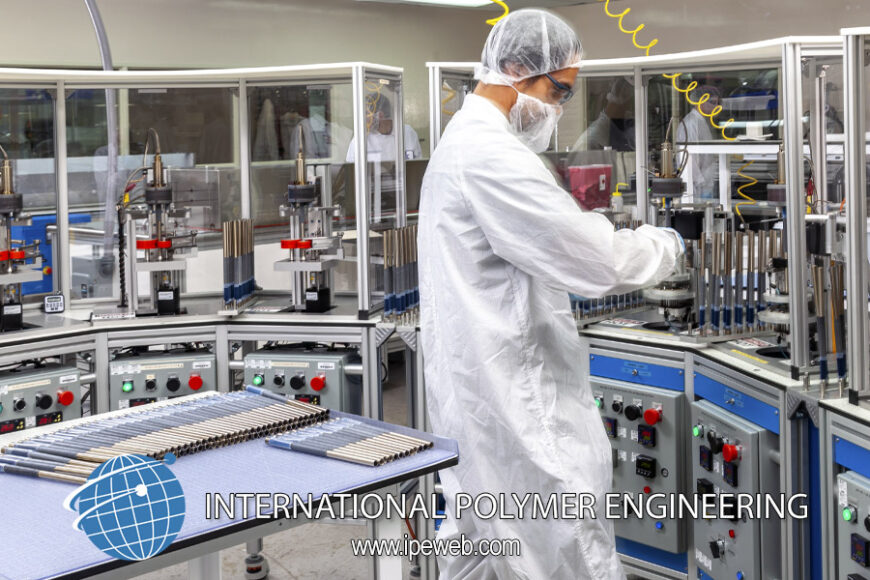
Surface preparation and material density play a key role in ensuring that good bond strength is achieved when bonding ePTFE. Plastic parts can have residual contaminates on their surface such as oils, dust, mold, paint, oxide film, release agents, or other surface contaminants. The amount of surface preparation required directly depends on the final bond strength and environmental aging resistance needed. Handling of porous PTFE without gloved hands can transfer skin oils to the surface making it extremely difficult to remove therefore, affecting bond strength. For example, to achieve a high strength structural bond all surface contaminates must be completely removed.
There are six standard methods for preparing an ePTFE surface for bonding:
- Abrasion
- Atmospheric Plasma
- Chemical
- Corona
- Degreasing
- Flame Treatment
A combination of degreasing, abrasion, and chemical treatment techniques can be employed for preparing plastic surfaces.
1.) Abrasion: Abrasion Methods include sandblasting, vapor honing and the use of other abrasive cleaning and finishing materials. Sandblasting, with fine sand, can only be used on substrates that are sufficiently thick enough so that they will not distort. The treated surfaces need to be degreased and cleaned before as well as after abrasion to remove any contaminants that may be present on the surface and to remove debris from the abrasion process itself.
2.) Atmospheric Plasma: Atmospheric Plasma Treatment is one of the three methods mentioned in this article that are considered “physical methods,” which means that they make use of the surface reactivity of the materials to modify the surface chemistry to achieve adhesion, rather than make use of hazardous chemicals. Plasma treatment differs from corona discharge and flame treatments in that plasma treatment is usually carried out under partial vacuum. In plasma treatment, gas plasma is activated to produce excited areas that react with the plastic substrate. Plasma treatment tends to provide better stability when compared to corona discharge, chemical treatment, or flame treatment.
3.) Chemical: Chemical Cleaning or Chemical Treatments are popular for preparing metals but can also be used, in certain circumstances, for a variety of plastics. Chemical cleaning changes the physical as well as the chemical properties of the surface in order to provide bonding sites to adhere the two surfaces. Fluoropolymer etching releases Fluorine atoms and exposes Carbon atoms for chemical attachment. This process is potentially dangerous and should only be done in the proper environment and with all recommended safety equipment. The layer of atoms that is removed is so thin that it is measured in angstroms (which is equal to one hundred-millionth of a centimeter). The etching process causes the PTFE surface to darken in color to a brown or tan hue, however the color is not an indicator of the effectiveness of the etch. Once the PTFE has been etched the surface can be glued, molded, or bonded to other materials. It also allows the PTFE tubing surface to be printed on or engraved. The properties of the PTFE are kept intact under the etched surface.
4.) Corona: Corona Discharge Treatment is another one of the “physical methods” for bonding. In this process, ionized air generated by the corona discharge reacts with the surface of the plastic to improve the wettability and adhesion of inks, coatings, and adhesives.
5.) Degreasing: Degreasing is done to remove any lose dirt or other contaminants from the surface of the plastic. Degreasing is generally only used when maximum adhesive strength or outdoor weather-resistance is not critical. Surfaces are cleaned with either a hot alkali solution or solvent vapor.
6.) Flame Treatment: Flame Treatment is the last of the “physical methods” in this article and is used in many applications for the food, automotive, medical, industrial tape, and textile industries. Flame treatment involves exposing the surface to be bonded to a gas flame for a few seconds. The flame oxidizes the surface to be bonded and increases the surface energy.
The next articles in this series will discuss the thermal fusion and reflow processing with ePTFE as well as thermal bonding of other polymers and bonding of ePTFE/PTFE or ePTFE/ePTFE. Keep an eye out for those in the coming months.
International Polymer Engineering is one of the only plastic extruders who specialize in manufacturing custom ePTFE FluoroFlex™ and thermoplastic products. On top of our state-of-the-art rod, tube, and sheet extrusions we also offer bending, flaring, precision milling, and bonding; as well as design & development, material testing & analysis, and clean room processing. We are also ISO 13485:2016 certified to ensure stringent quality standards. IPE is your total solution provider. Contact us to get started on your next project today!
